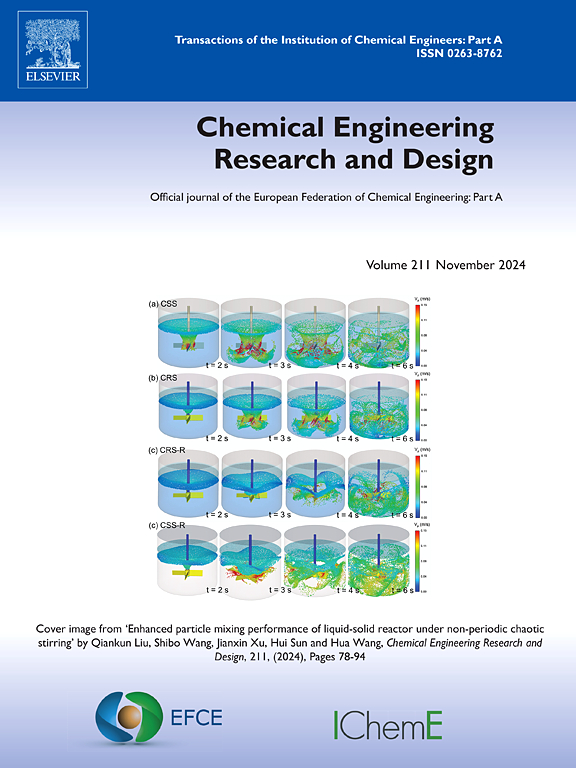研究用于紧凑型浮选机的喷射式锥形空气饱和器的气体溶解和微气泡生成特性
IF 3.7
3区 工程技术
Q2 ENGINEERING, CHEMICAL
引用次数: 0
摘要
产生高质量的微气泡是高效运行气浮装置的关键。为了解决传统溶解空气系统的局限性,本文介绍了一种将射流喷嘴与锥形垂直储罐相结合的射流锥形空气饱和器(JCAS)。将流体体积(VOF)多相流模型与实验分析相结合,对气相体积分布和溶解气性能进行了对比研究。在线测试结果表明,JCAS的气体溶解效率比垂直空容器高42.4 %,比常规射流型垂直溶解空气容器高29.5 %。气体溶解效率与气液体积比、液高比和溶解气体压力呈指数关系。理论预测模型与实验结果的偏差在15 %以内。溶解气水通过ts型溶解气释放器释放,生成高质量的微气泡。微泡的Sauter平均直径随气液体积比的增大而增大,随液高比和溶气压力的增大而减小。对比实验表明,采用射流锥形加压微泡发生器的紧凑浮选装置除油效率优于微孔管状微泡发生器。即使在平均油滴直径小至13.2 μm的情况下,该系统的除油效率也达到77.4% %,充分体现了射流锥形溶解气系统的先进性能和高效率。本文章由计算机程序翻译,如有差异,请以英文原文为准。
Investigation on the gas dissolving and microbubble generation characteristics of a jet conical air saturator for use in compact flotation unit
Generating high-quality microbubbles is critical for efficiently operating dissolved air flotation devices. To address the limitations of conventional dissolved air systems, this paper introduces a jet conical air saturator (JCAS) that integrates a jet nozzle with a conical vertical tank. A comparative study of gas-phase volume distribution and dissolved gas performance was conducted by combing the Volume of Fluid (VOF) multiphase flow model with experimental analysis. The online measurement results indicate that the JCAS achieves a gas dissolution efficiency 42.4 % higher than that of the vertical empty vessel and 29.5 % higher than conventional jet-type vertical dissolved air vessels. The gas dissolution efficiency exhibits an exponential relationship with the gas-liquid volume ratio, liquid height ratio, and the dissolved gas pressure. The discrepancy between the theoretical prediction model and experimental results is within 15 %. The dissolved gas water is released through a TS-type dissolved gas releaser to generate high-quality microbubbles. The Sauter mean diameter of the microbubbles increases with the gas-liquid volume ratio, while it decreases with the rising liquid height ratio and dissolved gas pressure. Comparative experiments show that the oil removal efficiency of a compact flotation unit equipped with the jet conical pressurized microbubble generator outperforms that of a microporous tubular microbubble generator. Even with average oil droplet diameters as small as 13.2 μm, the system achieves an oil removal efficiency of 77.4 %, highlighting the advanced performance and high efficiency of the jet conical dissolved gas system.
求助全文
通过发布文献求助,成功后即可免费获取论文全文。
去求助
来源期刊

Chemical Engineering Research & Design
工程技术-工程:化工
CiteScore
6.10
自引率
7.70%
发文量
623
审稿时长
42 days
期刊介绍:
ChERD aims to be the principal international journal for publication of high quality, original papers in chemical engineering.
Papers showing how research results can be used in chemical engineering design, and accounts of experimental or theoretical research work bringing new perspectives to established principles, highlighting unsolved problems or indicating directions for future research, are particularly welcome. Contributions that deal with new developments in plant or processes and that can be given quantitative expression are encouraged. The journal is especially interested in papers that extend the boundaries of traditional chemical engineering.
 求助内容:
求助内容: 应助结果提醒方式:
应助结果提醒方式:


